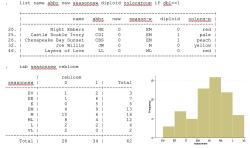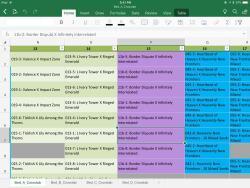As an addendum for those following this thread to learn more about how other people organize their daylily information, here's what I can do in my statistical software package.

I am growing, not just founder stock for daylily hybridizing, but also garden needs (full season of blooms from EE to VL, timing of bloom relative to other plants) and I am taking the daylily preferences of three other family members into consideration. This output was designed to help me make decisions about new daylilies to acquire in 2020. The top output was a list of my doubles, with their dominant color, dip/tet status, and bloom time listed. The bottom output shows the bloom time, with rebloomers noted, and on the right is a histogram of bloom season by registration. You can see I currently have 62 cultivars and more than half are rebloomers. I have a lot of mid-season (EM, M and ML) but far fewer early (EV, EE, E) or late (L, VL). Looking at this output, I decided I needed more doubles, particularly early or late season, and I needed more early or late season daylilies overall.
Here's what I do for bed location. All my beds are named, and I have this in the database such that I can list the daylilies according to any criterion I want. This shows the list ranked by scape height. I also have versions that include the new daylilies I want to add, and I use this system to help plan where I will put them, since (as many people do) I like to have the shorter-scape daylilies in front, but I also think about when daylilies bloom and sometimes will pair similar-height daylilies, one in front of the other, as long as they bloom at different times (of day: nocturnal v. diurnal, and of season: E v L).

As you can see, the output is basic (no frills, no photos). I code more in Stata (moderate cost, but a bit faster to learn than some programs, more information at:
https://www.stata.com), and I also do some coding in R-software (free and open-source, information at
https://www.r-project.org, with Coursera and other free online courses and tutorials available, but it has a steeper learning curve). I have a version of Stata that allows so many rows and columns that my daylily database is functionally unlimited in terms of data points.
The two major limitations to these kinds of programs are:
1. Users need at least some coding ability (usually takes most our our students 6 months to achieve a reasonable level of competency, given specific coursework and homework assignments designed to improve skills, but it is possible to gain many skills without the structure of a training program since the online community that supports these packages is soooo good).
2. Photos difficult to include, may be able to do via hyperlinks and/or macros (extensive coding skills needed). I have identified a few potential pathways that would let me do what I want to do with R software, but this approach would take me a LOT of time, and I have a bunch of students to graduate this year!
I hope this whole thread has been useful to those who want to think about a variety of options for management and visualization of our awesome daylily data! The main daylily database is such a wonderful resource, and I really am thrilled at the knowledge base among the community here!!
Meghan






